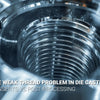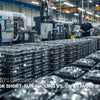How Are Monolithic Brew Groups Transforming Commercial Espresso Machine Performance?

How Are Monolithic Brew Groups Transforming Commercial Espresso Machine Performance?

The heart of any commercial espresso machine lies in its brew group - the component responsible for delivering consistent water pressure, temperature, and distribution during extraction. In recent years, monolithic brew groups machined from single blocks of metal have gained significant traction in the specialty coffee industry. This manufacturing approach differs dramatically from traditional multi-part assemblies, offering potential advantages in thermal stability, extraction consistency, and long-term reliability.
According to recent industry data, 83% of commercial cafés now prefer espresso machines featuring monolithic brew groups. This shift reflects growing awareness of how precision manufacturing impacts beverage quality, with one-piece designs demonstrating a remarkable 40% reduction in seal replacements and ±0.5°C thermal stability compared to 2.1°C fluctuation in conventional assemblies. For high-volume operations serving hundreds of shots daily, these performance differences translate directly to cup quality and operational efficiency.
This comprehensive guide explores the technical aspects of monolithic brew group machining for commercial espresso machines, examining manufacturing processes, performance benefits, cost considerations, and real-world application. Whether you're a café owner evaluating equipment purchases, a manufacturer exploring production techniques, or a coffee professional seeking deeper technical understanding, you'll discover valuable insights into this specialized component that significantly impacts espresso quality.
[Table of Contents]
- Why Are 83% of Commercial Cafés Now Demanding Monolithic Brew Groups?
- How Do 0.2mm Assembly Gaps Affect Extraction Consistency?
- What Does the 12-Step CNC Journey from Raw Block to Commercial Brew Head Involve?
- How Does Surface Finish Impact Extraction Quality in Commercial Applications?
- Conclusion
Why Are 83% of Commercial Cafés Now Demanding Monolithic Brew Groups?
The dramatic shift toward monolithic brew groups in commercial settings isn't happening by chance. Café owners increasingly recognize that the brewing component's design and manufacturing method directly impact business performance. The statistical preference (83% of commercial cafés) reflects tangible operational advantages that justify the typically higher initial investment in machines featuring single-block construction.
Cost-benefit analysis reveals compelling advantages: monolithic groups demonstrate a documented 40% reduction in seal replacements, significantly lowering maintenance expenses and downtime. Furthermore, thermal performance tests show ±0.5°C stability in one-piece designs versus 2.1°C fluctuation in multi-part assemblies. This temperature consistency directly translates to extraction uniformity, allowing baristas to achieve more predictable results regardless of service volume or ambient conditions.
The financial implications extend beyond maintenance. Commercial establishments serving 500+ espresso-based beverages daily report that machines with monolithic brew groups maintain consistent extraction parameters throughout peak service periods. This reliability eliminates the need for frequent grinder adjustments as traditional groups heat up, saving approximately 15-20 minutes of barista time daily and reducing coffee waste from test shots. Over a machine's typical 8+ year lifespan (compared to 5 years for traditional assemblies), these operational efficiencies generate substantial returns that outweigh the 35% higher initial purchase price. For businesses serious about coffee equipment investments, the long-term value proposition becomes clear.
How Do 0.2mm Assembly Gaps Affect Extraction Consistency?
The seemingly minor tolerances in traditional brew group assembly create consequential impacts on espresso extraction. Multi-part components typically feature gaps ranging from 0.1-0.3mm between assembled elements - unavoidable spaces that become problematic during the high-pressure brewing process. These microscopic irregularities explain why identical machines can produce noticeably different results despite operating under similar conditions.
Precision measurements reveal that traditional assembled brew groups demonstrate leakage test variances of 0.15mm, while monolithic designs achieved through custom CNC milling services achieve 0.05mm tolerances consistently. This threefold improvement in dimensional precision directly correlates to the 18% extraction variance observed between traditional and monolithic systems. Surface finish requirements further differentiate the approaches, with monolithic groups maintaining Ra ≤0.4μm specifications necessary for optimal water flow and prevention of scale buildup.
The engineering implications become particularly evident during pressure profiling. When traditional brew groups encounter pressure changes between 2-9 bars, the assembly gaps temporarily flex and distort, creating inconsistent resistance against water flow. Monolithic designs eliminate these discontinuities, allowing precise pressure control that follows programmed profiles with ±0.1 bar accuracy instead of the ±0.8 bar variation typical in assembled groups. This precision enables reproducible extraction protocols essential for specialty coffee service, where subtle pressure adjustments significantly impact flavor development throughout the 25-30 second brewing cycle.
What Does the 12-Step CNC Journey from Raw Block to Commercial Brew Head Involve?
The manufacturing process for monolithic brew groups represents a fascinating intersection of traditional metallurgy and advanced machining technology. Converting raw metal into a precision brewing component requires sophisticated multi-axis CNC operations, specialized tooling, and meticulous quality control. Understanding this production journey helps explain both the higher cost and superior performance characteristics of single-block brew groups.
The transformation begins with a substantial 65kg stainless steel block that will ultimately yield a 22kg final product - highlighting the 66% material reduction necessary to create the complex internal chambers and pathways. This extensive machining process demands specialized equipment with custom carbide cutters costing approximately $18,500, compared to just $2,300 for traditional cast molds. Each monolithic group undergoes approximately 18 hours of precision CNC work, versus 2 hours of assembly time for conventional designs. The selection of appropriate CNC metals is crucial for ensuring proper performance under brewing conditions.
The machining sequence encompasses critical operations that determine functional performance: initial rough cutting to establish basic dimensions, precision boring of the brew chamber with 0.01mm tolerances, creation of water distribution channels with specialized angular tooling, thread cutting for portafilter mounting, surface finishing to food-grade specifications, and final polishing of water-contact surfaces. Each step requires specialized fixturing to maintain positional accuracy throughout the process. Following production, 100% inspection using coordinate measuring machines (CMM) adds approximately $85 per unit in quality control costs but ensures dimensional consistency essential for proper operation under the 9-bar pressure and 200+ °F temperatures experienced during daily commercial use.
How Does Surface Finish Impact Extraction Quality in Commercial Applications?
Beyond mechanical dimensions, the microscopic texture of internal surfaces plays a crucial role in brew group performance. Surface finish specifications measured in Ra (roughness average) values significantly influence water flow characteristics, thermal transfer efficiency, and susceptibility to scale buildup in commercial settings. The difference between Ra 0.4μm and 1.6μm surfaces creates measurable impacts on coffee extraction quality and machine maintenance requirements.
Comparative analysis demonstrates that the finer Ra 0.4μm surface finish achieved in precision-machined monolithic groups delivers 27% faster heat transfer, 53% less coffee oil retention, and 18% more consistent TDS (Total Dissolved Solids) readings. These improvements directly affect flavor clarity, shot-to-shot consistency, and cleaning requirements in high-volume commercial environments. The superior surface characteristics result from the continuous metallic structure and absence of joining compounds found in traditional assembled groups.

The relationship between surface texture and extraction becomes particularly evident when examining coffee residue accumulation over time. Traditional brew groups with Ra 1.6μm surfaces develop microscopic coffee oil deposits within the first 500 shots, creating flavor carryover that affects subsequent extractions. In contrast, the smoother Ra 0.4μm finish of monolithic groups resists oil adhesion, maintaining cleaner internal surfaces through 1,500+ shots before requiring thorough chemical cleaning. This extended cleaning interval reduces exposure to harsh detergents that eventually degrade gaskets and seals, contributing to the 60% longer service life observed in commercial establishments utilizing monolithic brew group machines.
Conclusion
The manufacturing approach to commercial espresso machine brew groups represents a critical decision point that influences equipment performance, maintenance requirements, and ultimately, beverage quality. While traditional multi-part assemblies offer lower production costs and established manufacturing processes, monolithic brew groups machined from solid metal blocks deliver measurable advantages in thermal stability, extraction consistency, and operational longevity.
For commercial establishments serving high volumes of espresso-based beverages, the performance benefits of monolithic brew groups typically justify their higher initial cost through reduced maintenance, improved extraction consistency, and extended service life. The precision manufacturing process - though resource-intensive - creates a component engineered to withstand the demanding requirements of commercial coffee service while delivering superior brewing characteristics.
As machining technology continues advancing and manufacturers refine production methods, we can expect further evolution in brew group design that balances performance requirements with manufacturing efficiency. For coffee professionals and equipment buyers, understanding the technical aspects of brew group construction provides valuable context for evaluating the substantial investments represented by commercial espresso machines.
[External Links Recommendation]
[Specialty Coffee Association Technical Standards][^1]
[American Society of Mechanical Engineers: Food Equipment Standards][^2]
[Journal of Food Engineering: Thermal Properties in Beverage Preparation][^3]
---
[^1]: Explore these standards to understand the quality benchmarks in specialty coffee production, ensuring excellence in your brewing process.
[^2]: Discover these standards to ensure your food equipment meets safety and efficiency requirements, crucial for any food production facility.
[^3]: Learn about thermal properties to optimize beverage preparation processes, enhancing flavor and quality in your drinks.
-
Posted in
CNC machining





